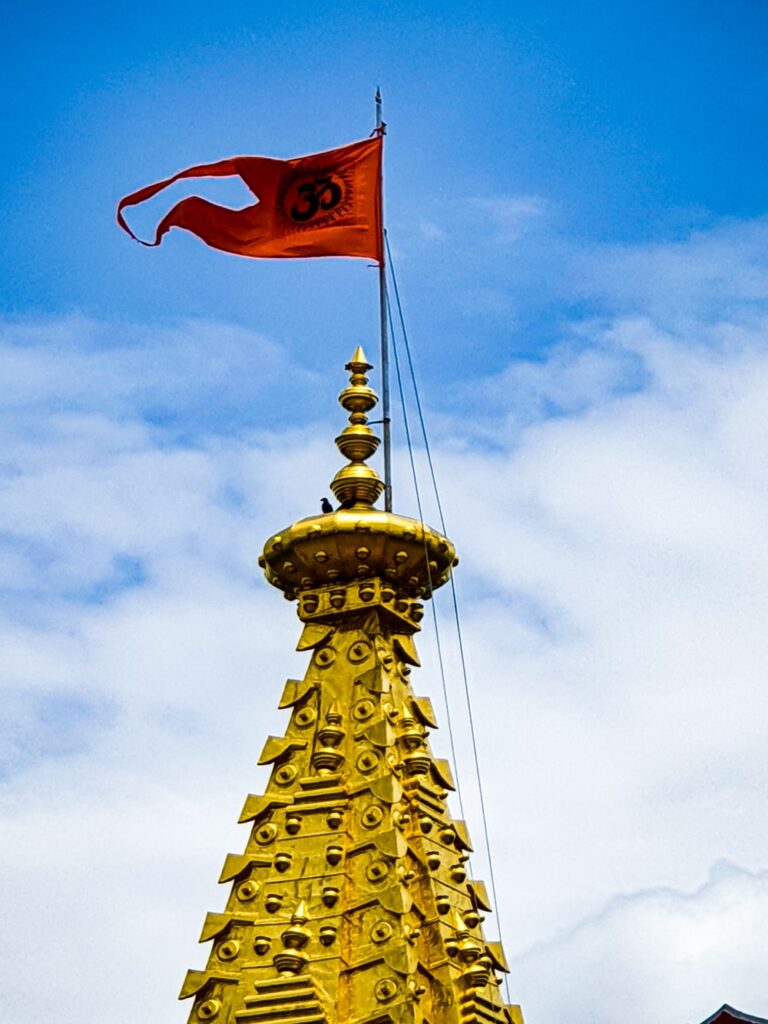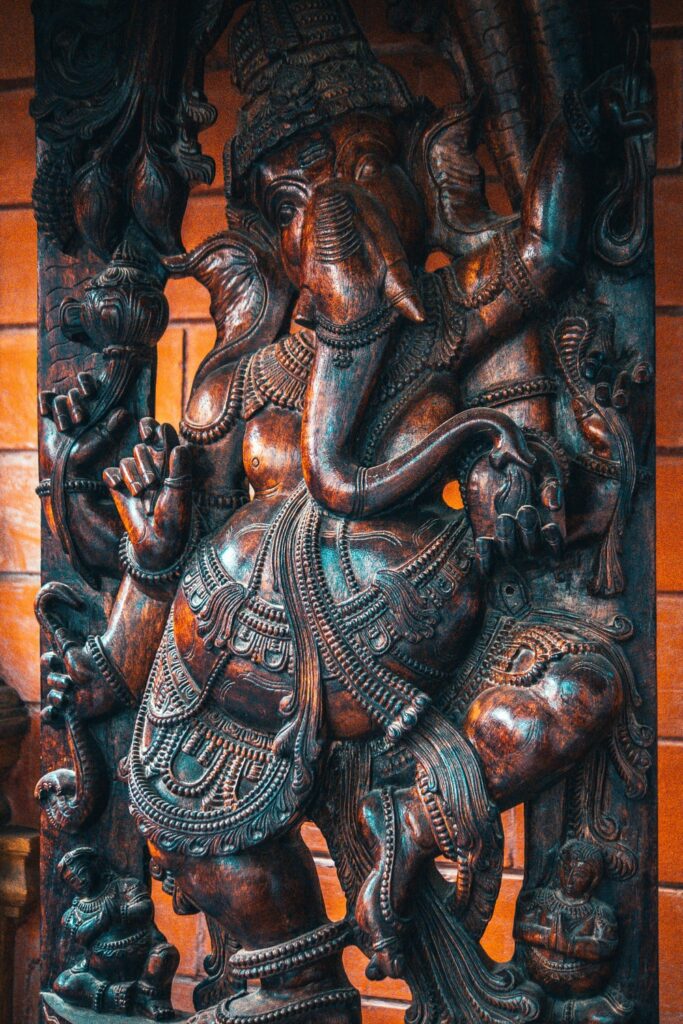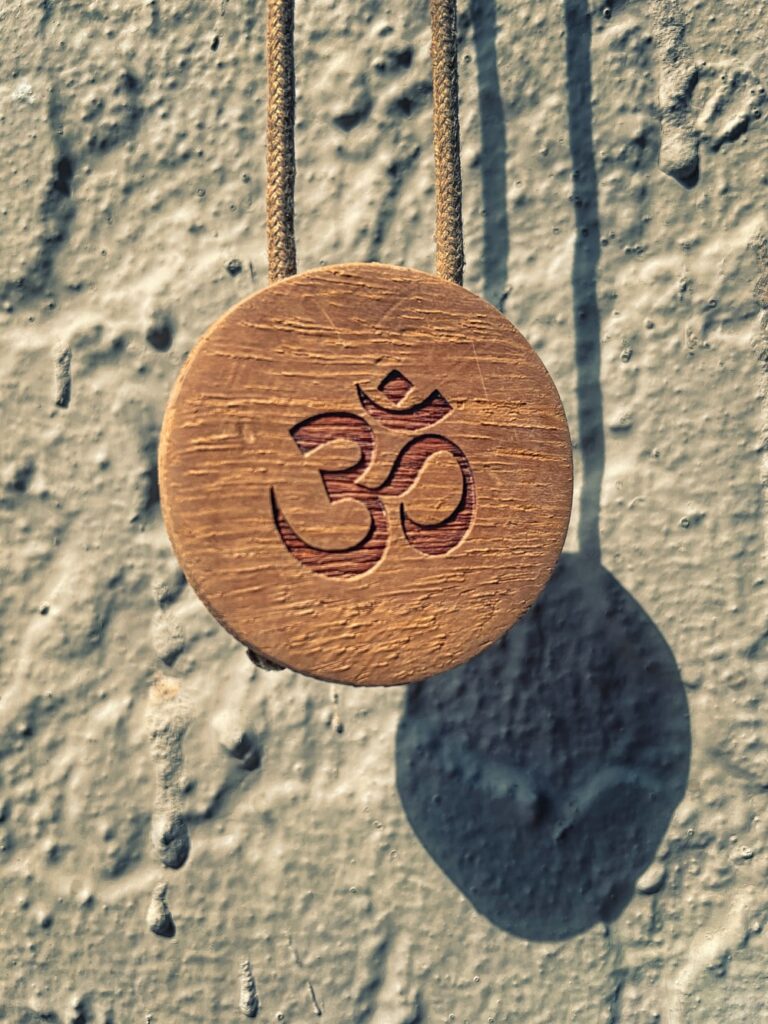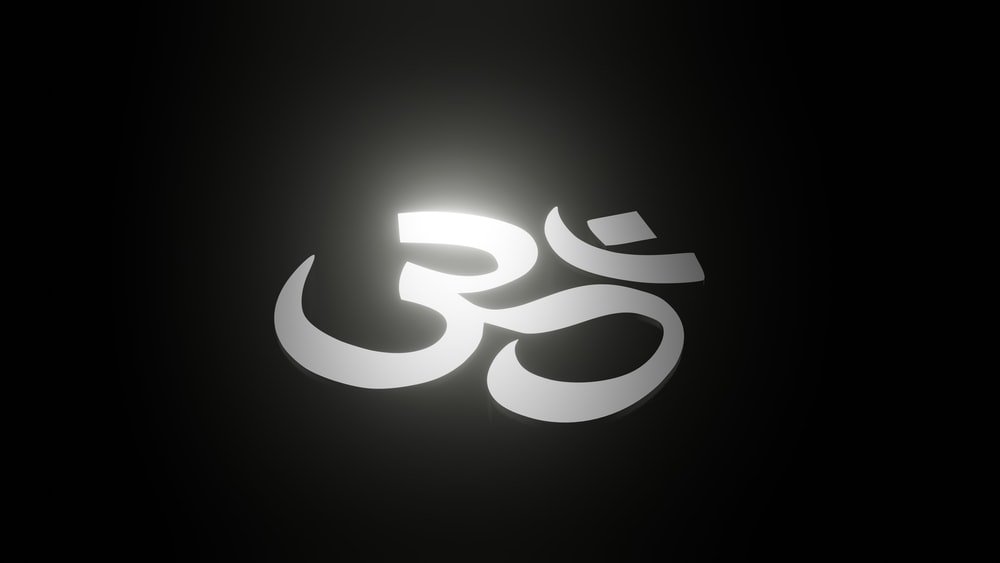Listen to this article:
Whether you’ve seen it on yoga clothing, as a tattoo, on jewelry, or painted on the wall of a yoga class, the Om symbol (ॐ) is a universal representation of yoga and meditation practices. You have probably heard it chanted in yoga classes and repeated in meditation practices. It is a reminder of peacefulness, unity, and spirituality that can now be found around the world.
The Om symbol represents the truth of ultimate reality, as well as a oneness and connection with the whole world. It is a sacred syllable that originated in the ancient teachings of Hindu and Buddhist religions.
Both the visual and audible elements of this traditional symbol have profound, often hidden meanings. The sound Om itself represents the primordial beginnings of the universe and can be chanted to activate the third eye, crown chakra, and even the vagus nerve (more on this below).
But there is so much more to this symbol than just a chant or the “3-shaped” design. If you’re confused about the Om symbol meaning, its history, and the spiritual meaning (and even physical health benefits) of chanting Om, this is the article for you.
Contents
- 1 What does the Om symbol symbolize?
- 2 How do you pronounce Om or Aum?
- 3 The Sacred Sound of Om
- 4 Science of Om and the Nervous System
- 5 Meaning of Chanting Om Mani Padme Hum
- 6 Origins of Om Symbol
- 7 Is it okay to wear Om symbol?
- 8 Using Om in a Yoga Class
- 9 Key Takeaways: The Om Symbol Meaning is Complex and Spiritual
- 10 FAQs
What does the Om symbol symbolize?
Om (or Aum) is an ancient sacred sound and symbol closely linked to spiritual awakening. It is one of the most important spiritual symbols in Eastern philosophy.
At its core, Om represents Ultimate Reality. In other words, it encompasses all the spiritual states one can exist in. It also symbolizes the Universe as a whole. It is said that, at the dawn of creation, Om was the first syllable to emerge from the emptiness.
The 3-shaped imagery of Om is also representative of a holy trinity that links together many symbols of “threes” in Eastern philosophy:
- The three letters A U M: The sacred Om syllable is actually pronounced more like “a-u-m” during chants and mantras
- The three worlds: Earth, ether, and atmosphere
- The three aspects of time: Past, present, and future
- The three holy trinity, or three Hindu deities responsible for creating, upkeeping, and destroying the world: Brahma (Hindu God of Creation), Vishnu (Hindu God of Preservation), and Shiva (Hindu God of Destruction of the Universe)
- The three original scriptures of the Vedas: Rg, Yajur, and Sama
- The three qualities, or “gunas”, of nature: Sattva (harmony), Raja (movement), and Tamas (inertia)
- Three different states of consciousness: The waking state, the dreaming state, and the deep sleep state
This final point is particularly poignant in the visual symbolism of Om because each curve of the calligraphy represents a different state of mind or consciousness:
- The Waking State: The lower left curve symbolizes regular waking life, or our lowest level of spiritual existence based solely on the material world.
- The Dream State: The right middle curve represents the state between waking and unconsciousness, or the dreaming state
- The Unconscious State: The left upper curve stands for the subconscious or unconscious mind of “deep sleep”. This is where the mind shuts down and doesn’t desire anything.
In addition, the other two key marks of the Om symbol complete the representation of the psycho-spiritual journey:
- Maya (Illusion): The top upper curve or semicircle is symbolic of all the obstacles to spiritual development. These illusions can come from society or the world and block us from enlightenment.
- The Transcendental State: The ultimate state of spiritual bliss is represented by the dot at the very top of the symbol. This is the highest state of consciousness where one can just Be, without influence from the outer world.
How do you pronounce Om or Aum?
Om is pronounced with three phonetic components:
- A= aaauuu (represents creation, or the waking state)
- U= ooooo (represents manifestation, or the dream state)
- M= mmmm (represents destruction, or the unconscious state)
Om chanting can help bring a peacefulness and spiritual awareness into your body. You should breathe inhale before beginning the sound and hold each syllable for as long as possible during the exhale.
As you repeat the mantra, it helps to focus on the vibrations in your body, specifically the vocal cords, chest, and stomach. This resonance is has a plethora of physical benefits as well as mental benefits, including:
- Lowering blood pressure
- Relaxing the stomach
- Calming the mind
- Harnessing creative energy
- Bringing spirituality into everyday unenlightened life (don’t worry, Om is still useful for those of us who aren’t an enlightened Buddha)
- Purposefully beginning or ending a yoga class by reminding ourselves that yoga is far more than a physical asana practice
Here are some powerful tips from Dr. Hansaji Yogendra for properly chanting Om:
The Sacred Sound of Om

Om is considered sacred and should never be used in a derogatory or disrespectful way. The sacred syllable Om is a bija or seed mantra. It is incorporated into nearly every Sanskrit chant or mantra. While there are seed mantras for every chakra (energetic center) in the body, Om is the most commonly used bija mantra in meditation. It is directly correlated with Sahasrara (the crown chakra), which is linked to enlightenment and spiritual transformation.
Both Buddhist and Hindu traditions assert that the om sound energizes and aligns the chakras. It helps us connect to our divine spiritual core and harness a sense of inner peace.
In Hinduism, the sound Om (or Aum) is considered the first sound of the universe. The vibrational frequency of Aum is believed to be the origin of all other sounds, vibrations, and life forms. Because it is the primordial sound of the universe, chanting Om is particularly transcendental. It calms the mind and senses, syncs the breath, and helps practitioners reach a more elevated consciousness.
In Buddhism, the Om sound is considered the sound from which the gods were created. It is often the very first word in a Buddhist mantra. In Tibetan Buddhism, the syllable Om represents the ultimate reality and the final truth of all things that exist.
Similar to the Christian use of “amen” or the Islamic “amin”, the word Om is often chanted at the end of a prayer to evoke more divine energy.
Science of Om and the Nervous System
Interestingly, modern research has found that chanting Om can activate the Vagus Nerve. This is the largest nerve in the body that helps regulate the parasympathetic nervous system. As opposed to the “fight or flight” sympathetic nervous system, the parasympathetic nervous system helps your body enter a “rest and digest”. It is linked to controlling your mood, blood pressure, heart rate, and level of calmness.
Chanting Om for as little as 5 minutes nerve is scientifically proven to help:
- Promote relaxation
- Lower heart rate
- Reduce anxiety
- Get out of “fight or flight” mode
- Reduce stress
- Reduce depression
- Elevate mood
Neuroscience research has even found that the vibrational effects of the audible Om chant help activate the resting parts of the brain. In the future, vagal nerve stimulation and chanting om may be used as a treatment for depression and epilepsy.
Meaning of Chanting Om Mani Padme Hum

The syllable Om is the beginning of a vast range of chants and mantras. You can also chant Om on its own for the powerful effects described above.
One of the most popular chants in Tibetan Buddhism is Om Mani Padme Hum, which literally translates to “praise to the jewel in the lotus”.
These words are often repeated between 21 and 108 times for a divine blessing. This mantra is considered to be healing and purifying. It is important to think about yourself and all the human beings, animals, insects, and plants in a compassionate way while repeating this chant.
The meaning behind Om Mani Padme Hum requires a metaphorical investigation into its Sanskrit roots:
- Om: In this chant, the word Om signifies the beginning a blessing and the practice of generosity.
- Ma: Ma means practicing pure ethics.
- Ni: Ni is all about tolerance and patience for yourself and for others as you work toward reaching spiritual perfection.
- Pa: The fourth syllable signifies perseverance in ones meditation practice and spiritual awareness.
- Me: This syllable represents concentration.
- Hum: The final syllable is about achieving perfection through wisdom.
This interpretation is from Dilgo Khynetse Rinpoche in The Heart Treasure of the Enlightened Ones. You can see that perfection is a really common theme in the Buddhist associations with the Om symbol. That’s because this symbol is all about wholeness, cohesiveness, and a perfect oneness with the everything in universe.
Origins of Om Symbol

The Om symbol was first mentioned in ancient texts called The Vedas some 5,000 years ago. It was likely first proposed in the last books of the Vedas called the Upanishads. The Upanishads covered a wide range of esoteric teachings from sages and gurus, including meditation, consciousness, philosophy, and a variety of rituals and ceremonies.
The aim of these religious texts were primarily to figure out the nature of the Atman (self) and how to harmonize oneself with the universe. Written in the traditional language of Sanskrit, these religious and spiritual teachings would later form the foundation for Hinduism, Jainism, Sikhism, and Buddhism.
The Om symbol quickly became revered by Eastern faiths and has since been incorporated into religious texts, inscriptions, and traditions around the world. It has been interpreted as a mystic sound, a tool for meditation, and as an affirmation to something divine. It can be found throughout Southeast Asia painted on temples, engraved on statues, in depictions of gods, as well as a core component of sacred tattoos.
The Om symbol has also found its way to the Westernized world through the popularity of yoga, meditation, and Eastern philosophical practices.
Is it okay to wear Om symbol?

The Om symbol is considered cross-cultural and not particularly affiliated with any one religion or belief.
Even in India, there is conflict amongst different groups about whether or not it’s ok to wear the Om symbol in jewelry, clothing, or other expressions. Some Hindus assert that it is not offensive as long as the Om is held in a respectful sense (for example, as earrings or a ring, but not as a bathroom accessory or joke). In this sense, the wearing the Om symbol represents positivity, joy, unity, and a reminder to cultivate spiritual awareness in your daily life.
Other Hindus find wearing the Om symbol as insulting, especially when it is accessorized by non-Hindu westerners. As with Buddha or Unilome tattoos, some also believe that getting the Om symbol tattooed on your body is a form of cultural appropriation that is disrespectful to Hindu tradition.
Your decision to wear the Om symbol is a personal one. This is one of the most important spiritual symbols for yoga, Hinduism, Buddhism, and Eastern philosophy.
If you understand the Om symbol meaning and use it in a respectful way, you may find it perfectly moral to wear the Om symbol on your body. It can also be incorporated into your yoga and meditation practices in both its audible and visual form.
Using Om in a Yoga Class
If you are an avid yoga practitioner or yoga teacher, you may wonder how or why many yogis chant Om before or after a yoga practice. Sharing in a resonant vibration with your students can be impactful and unifying. It also activates a state of calmness before entering meditation or Savasana.
Regardless of if you follow Buddhist or Hindu faith traditions, it is typically considered acceptable to chant Om in a yoga class as long as it is used in a respectful manner. After all, Om represents compassion, acceptance, and oneness with the entire universe. The Aum chant reminds us that yoga is far more than just a physical (asana) practice.
When leading an Om chant, consider explaining the significance of each part of the syllable Om:
- A: “Ahhh” or “awe” starts at the back of the throat and gets stretched out, vibrating your chest. It symbolizes the waking state and creation.
- U: The second syllable is pronounced as a long “oooo” that gradually rolls forward along the upper palate of the mouth. It should vibrate the throat. This represents the dream state and manifestation.
- M: The long “mmmm” part of the Om syllable involves lightly touching the front teeth. This vibrates the top of the mouth and signifies the unconscious state or deep sleep state and destruction.
- Silence: The final syllable of Aum represents the silence of the infinite universe. As the “mmm” fades off, allow the room to become completely silent before starting the next round of Om chanting.
Bringing all of these sounds together helps echo the sound of the universe and integrate mind, body, and spirit into one. You can chant Om as many times as you’d like, however, 3 to 9 times are the most common.
Key Takeaways: The Om Symbol Meaning is Complex and Spiritual
These days, the Om symbol is found nearly everywhere in the yoga world, yet most people don’t understand its historical and spiritual meaning.
As a sound, Om is a mystic syllable that symbolizes the origin of the Universe, according to Hindu belief. It was the very first sound of creation and is also considered a seed syllable for Sanskrit chants and mantras. It was first written in the ancient Vedic texts some 5,000 years ago.
In its visual form, the Om symbol represents a variety of holy trinity references as well as the three main states of consciousness: waking state, dream state, and deep sleep.
Both the auditory and visual form of Om can be used to elevate your spiritual awareness and help you connect to higher levels of consciousness and inner peace.
Namaste!
FAQs
What does this symbol mean 🕉?
The 🕉 emoji is the Om symbol, which represents the primordial sound of the universe and symbolizes the ultimate spiritual state of connecting everything together in oneness.
Is Om a religious symbol?
The Om symbol is a spiritual symbol closely associated with Hindu and Buddhist philosophy. However, it is widely used in yoga and meditation practices and isn’t necessarily exclusively linked to these religions. Om symbolizes the consciousness or sound of the universe and is often used in chants and mantras, as well as decorations, altars, and clothing.


